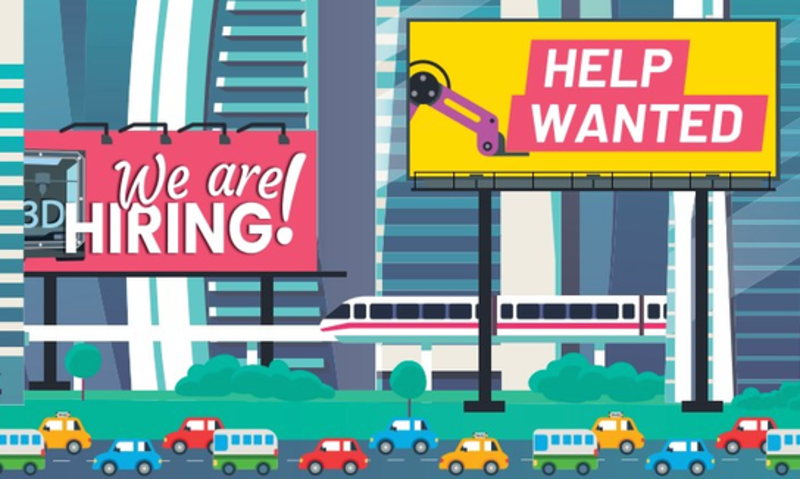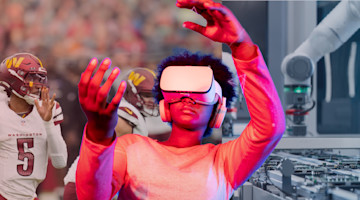If you think about the billboards in areas like Pittsburgh, Cleveland, and Detroit in 2019 and early 2020, you probably picture ads for liquor, lawyers, and the lottery.
But then COVID hit.
Then, as companies worked their way through the Paycheck Protection Program (PPP) to get to the other side of the pandemic, to what could be considered “normal,” new billboards began to appear – the likes of which had never been seen before. Suddenly, they displayed help wanted ads from industrial companies of all sizes.
Here’s how things changed:
The Bureau of Labor Statistics (BLS) reported that U.S. civilian unemployment was at 3.5% in February 2020. Economists who use the NAIRU macroeconomic metric – the non-accelerating inflation rate of unemployment – typically consider “full employment” in the United States to be 4% to 5%. A simple way to think about it is as the lowest sustainable rate of unemployment that doesn’t cause inflation. So, in February 2020, the country was easily at full employment.
Just two months later, in April 2020, the BLS reported U.S. unemployment was 14.8%.
Improved but Challenging
The U.S. economy is nothing if not resilient. By December 2020, unemployment declined to 6.7%, then to 3.9% in December 2021, 3.5% in December 2022, 3.8% in December 2023, and 4.1% in December 2024.
And while the billboards began to come down, there was – and is – an abiding challenge facing industrial companies across the board. To borrow the title of a 1953 short story that you may recall from high school: “A Good Man Is Hard to Find.”
Finding people who can handle today’s tools is simply not easy, male or female. But it is necessary. Critical. And arguably different from what it was for many years.
Consultancy PwC recently released its “2024 Workforce Radar Report.” Anthony Abbatiello, the workforce transformation practice leader at PwC U.S., was one of the authors of that study, which included surveying more than 18,000 employees, 2,600 business leaders, and 1,300 HR leaders. The report is both diagnostic in what it sees going on in the workplace and prescriptive for what leaders must do to hire and keep the people their companies need.
You might have thought the word “critical” a couple of paragraphs above is an exaggeration. It is not.
Will You Be Viable?
The PwC workforce report states: “45% of CEOs in PwC’s 27th Annual Globe CEO Survey told us their organizations won’t be viable in 10 years if they stay on their current path.”
Abbatiello explains that these executives believe “consolidation will ultimately reduce competitors in their space” – meaning their company could get consolidated out of existence – “or with the pace of technology, there may be an obsolescence of their business.” What’s more, he notes many companies are divesting businesses and focusing more on specific operations.
This means: (1) They need to have a strategy for their business that will be sustainable for at least 10 years, and (2) they need a workforce that can execute.
Abbatiello and his colleagues recommend that in order to best position a company, it needs to become a talent magnet and a talent factory, where internal talent development occurs that tracks with the company’s strategic needs.
The Magnet and the Factory
Abbatiello emphasizes that a company being a talent magnet or talent factory isn’t a case of being one or the other:
“It is an ‘and.’ They have to be both. Depending on where they are in terms of their business cycle – say reinventing their business or being a nascent startup in a growth mode – they have to use both the dials of talent magnet and talent factory to drive their business.”
Abbatiello acknowledges that a company in growth mode requires the right talent. In these cases, being a magnet is important.
“But in more mature sectors, where they may not be doing a ton of hiring, it is really about dialing up the talent factory piece – but that doesn’t mean they can abandon being a talent magnet.”
Being a talent magnet means making the company a desirable place to work by publicly emphasizing its external brand, employee value proposition, and other company characteristics with which people would want to associate.
A talent factory is where learning platforms and leadership training benefit employees and are tailored to benefit the overall organization.
Abbatiello puts it plainly: “There is a fight for in-demand skills. Skills are the new currency.”
You want to get them (magnet). You want to maintain and optimize them (factory).
Not Easier Soon (If Ever)
As it says in the PwC report:
“The battle for top talent is fierce, and there’s no reason to think that ‘talent wars’ will end anytime in the next three years. In fact, in an ever more complex world with ever more complex technology available, the people who have the right skillsets, mindsets, and attitudes will likely continue to be in high demand.”
While many company leaders think learning and growth opportunities are both readily available for their employees, the PwC survey shows otherwise: Only 47% of employees say their company offers adequate opportunities to learn new skills, and 30% don’t think their companies offer upskilling opportunities. Instead, they go outside to find those skills.
Said another way: Fewer talent factories exist than people think.
Offering the workforce the means to build a future generates positive results: Employees are 1.7 times more likely to stay and are 2.3 times more engaged in their work.
And they even contribute to making the company a talent factory: They are 2.4 times more likely to recommend their company to other people.
What Do People Actually Want?
One of the things the PwC researchers discovered is a tendency for leaders at organizations to inaccurately assess what they’re offering their workers. That is, while 96% of business leaders think what they offer is special, 25% of their employees disagree.
Abbatiello explains, “Organizations respond to what they believe is what the workers need and are asking for versus looking at preferences of the different demographics or archetypes or personas of the workforce.”
For example, PwC researchers found that there are differences in what people who make less than $75,000 per year want compared to those who are making more (although Abbatiello points out that everyone wants to make more money). What’s more, not having a clear understanding of the preferences can cost a company more money than it needs to spend; Abbatiello says they’ve found, for example, that some companies, not understanding the preferences of their workers, can overspend from $1,000 to $3,000 per annum on health and welfare benefits. It may look good to them, but it may not be valued by the workers.
Create a Talent Architecture
While “demographics or archetypes or personas of the workforce” may sound rather complex, if not convoluted, having a deeper understanding of their people is highly beneficial to a company.
PwC recommends that companies build a talent architecture that organizes the skills and abilities of its workforce. This is extremely useful for training and developing personnel to meet current and future needs: If someone has an aptitude in one area (such as IT), that person may be better suited for training in a particular area (like AI) than someone without that orientation.
Know the Discipline — and Critical Thinking
What are important attributes for someone looking for a job, whether it is at an entry level or a lateral move? Abbatiello says having “hard skills” within a discipline – proficiency in a particular domain (think equipment operation or CAD software) – is important now and always will be.
But something is changing:
“What is apparent today is that softer skills are becoming harder: Critical thinking, problem-solving, empathy, interpersonal communication, agility, resilience – those are the skills more attractive today. We need those softer skills more than the technical, harder skills.”
This is not a contradiction vis-a-vis having domain expertise. Rather, as changes in technology accelerate – AI, automation, etc. – the need for people to understand and adapt to those changes grows. The ability to deal with changing demands and needs is becoming increasingly important. Resilience trumps rigidity.
Return to Office: How Come?
One consequence of the COVID pandemic in the United States was the explosive growth in the number of people who abandoned their offices and worked from home.*
Now, an increasing number of companies have decided that since they have the space, desks, equipment, and other amenities, it is back to the office.
Anthony Abbatiello, workforce transformation practice leader, PwC U.S., says, “I believe in physical location.”
He acknowledges, “I’m an extrovert. I enjoy bouncing ideas off colleagues, intellectual debate. I like the collaboration. For me, that works.”
But he adds an important caveat: “That doesn’t mean that’s a strategy.”
While some companies simply mandate it, Abbatiello believes there must be a strategic purpose behind returning to the office.
“Mandates don’t work,” he says. “Just saying ‘get back to the office’ doesn’t work because some people are going to spend more time trying to circumvent the process rather than actually working.”
As a result, productivity can be lost.
“If there’s a benefit through collaboration or idea exchanges, and we want to use physical location as a way to do that, that makes sense. Make it transparent to the employees so they understand what it is going to bring the company.”
Abbatiello says that it isn’t usual for him to walk though client organizations and see “people with headphones on, sitting in front of a screen, not talking to peers or asking questions.”
What’s more, he’s found that companies housed in large buildings tend to have Zoom calls rather than having workers walk to another floor to meet with people.
“Provide meaning and purpose for being back in the office beyond free food on Wednesdays,” he says.
* The PwC “2024 Workforce Radar Report” found that workers who couldn’t work from home – “shift workers on the plant floor, the people climbing utility poles, flying planes or ringing up merchandise” – are no different than office workers when it comes to flexibility. While those able to work from home were able to achieve greater flexibility, that wasn’t necessarily the case for those whose jobs don’t lend themselves to that situation.
Still, PwC has some suggestions that companies can offer on-site workers:
Flexible scheduling and start times
Shift swapping
Varied shift durations
PwC found that only 48% of people who work on-site think their work schedules are flexible enough to meet their personal needs. In contrast, 67% of office workers say they have that flexibility.
Consider the Startup Alternative
A few days before we spoke with Alisyn Malek, General Motors laid off dozens of workers in an assessment that was going to run for weeks. Last November, the company laid off about 1,000 salaried and hourly employees. In August, it laid off more than 1,000 people in its software and services organization.
Malek began her career at GM as a design release engineer and vehicle systems engineer for advanced charging systems. She later did a stint at the corporation’s venture capital arm, GM Ventures. In 2017 she co-founded May Mobility, a company developing and deploying autonomous vehicle tech. May Mobility’s investors include Toyota and BMW. She went on to found Middle Third, a company dedicated to helping startups in the mobility space and early and mid-career professionals who venture into the startup sphere.
Reflecting on the GM announcement, Malek, who is working to attract talent to Michigan, describes it as “frustrating.”
Malek says, “They couched it as ‘performance reviews.’ I know that when I was at GM, I had at least two leaders who would have liked to have ‘performance reviewed’ me right out of there.”
It is worth noting that Malek has attained accolades, including being named a Top Ten Female Innovator to Watch by Smithsonian Magazine and an Automotive News All-Star – clearly the sort of person you’d want in your organization.
Given the churn happening in large corporations like GM, where people are being let go for these companies to cut costs in a major way, Malek says an alternative for some people may be to go work at a startup.
Although many startups are associated with developing software programs and apps, Malek points out that plenty are working on what she refers to as “hard tech.”
“There is a ton of attention in the manufacturing space.”
While people who have recently graduated or have decades of experience may think going to a startup is risky and prefer getting into a larger company or staying in one, she notes, “People used to consider big companies because they were stable, that your job was guaranteed.”
Clearly, that’s changed. Big or small, established or newly launched, “It’s all risky at this point.”
But she thinks that there are great opportunities in the startup route. For one thing, these small companies are looking for self-starters who want to get things done. This can be particularly valuable for those who are pigeonholed in their current job.
“You don’t have someone looking over your shoulder all the time,” she says.
While there might be some concern about benefits, she says that a startup that has raised outside investments or has signed up a good customer typically provides a package that includes benefits like health insurance and vacation.
What is typically not included is a 401K. Instead, employees often receive an equity grant so they can buy into the company they’re helping to create.
How does one find a startup opportunity? Simply Googling for startup meetings in your city is a good way to start. Cities and states are increasingly interested in having startup companies in their locales, so you may be surprised at the available resources.
One thing to consider about finding a job with a startup versus a big corporation: According to Resume Builder, 82% of larger companies use AI to review resumes. But, if you’re at a meetup for startups, you can probably talk with someone that you may go on to work with.
To read the rest of the Workforce Issue of MT Magazine, click .






